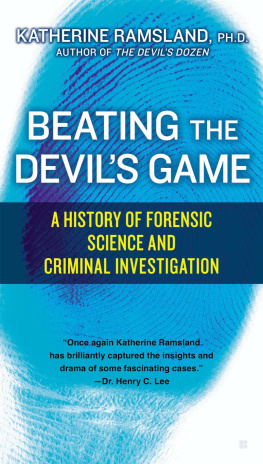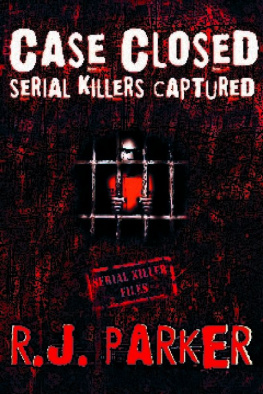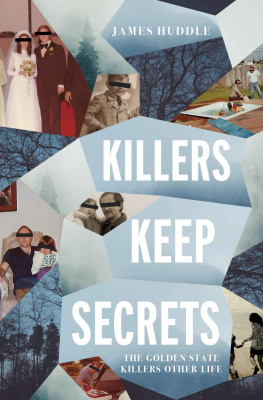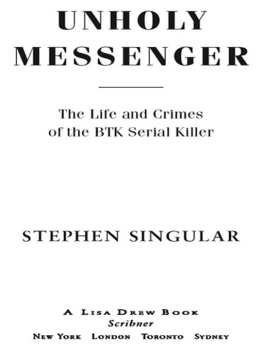

ForeEdge
An imprint of University Press of New England
www.upne.com
2016 Katherine Ramsland
All rights reserved
For permission to reproduce any of the material in this book, contact Permissions, University Press of New England, One Court Street, Suite 250, Lebanon NH 03766; or visit www.upne.com
Library of Congress Cataloging-in-Publication Data
Names : Ramsland, Katherine M., 1953
Title : Confession of a serial killer: the untold story of Dennis Rader, the BTK killer / Katherine Ramsland.
Description : Hanover: ForeEdge, 2016. | Includes bibliographical references and index.
Identifiers : LCCN 2016009536 (print) | LCCN 2016015057 (ebook) | ISBN 9781611688412 (cloth) | ISBN 9781611689730 (epub, mobi & pdf)
Subjects : LCSH: Rader, Dennis, 1945 | Serial murderersKansasWichitaBiography. | Serial murderersKansasWichitaCase studies.
Classification : LCC HV6248.R24 R35 2016 (print) | LCC HV6248.R24 (ebook) | DDC 364.152/32092 [B]dc23
LC record available at https://lccn.loc.gov/2016009536
To Karl Berg, Who inspired me, and to my associates Who encouraged me CONTENTS
ACKNOWLEDGMENTS
Completing this book has been a long process and there are many to thank.
John Silbersack, my agent and friend, had vision. Despite the many twists and turns of getting this book to a publisher, he showed incredible persistence and stamina.
None of this would have happened without Kris Casarona and Jim Thompson. Kris first contacted Dennis Rader in 2005 and collected an enormous amount of material from him about his life before I came along. In the hope of benefiting the victims families, she willingly shared it and stood by as an advisor. Attorney Jim Thompson kept the files safe and provided a place for me to go through them. He also accompanied me on some trips in Wichita and assisted with the process at El Dorado Correctional Facility.
Members of the Victims Family Trust approved me for this work, although I know that they would prefer that Dennis Rader had never existed.
Former Sedgwick County district attorney Nola Tedesco Foulston provided a large cache of material from the investigation, along with photos from her files and encouragement to ensure a benefit to professionals. She kept the late Lieutenant Ken Landwehrs legacy alive with constant reminders of his work on the BTK investigation.
OUG s Sally Keglovits and Dana DeVito were my main emotional support during those days when this work felt very dark. Sally injected optimism all the way through, and as the go-to researchist on the Clutter family murders, discussed this angle with me.
My assistant, Alina Edinger, slogged through proofreading and helped me to get items from Raders letters on paper when my work duties deflected my focus.
Al Carlisle generously allowed me to publish a chunk of his work on compartmentalization.
Gregg McCrary, a long-time friend, had the FBI profiling background to discuss many of the criminological aspects with me.
Dr. Mimi Meyerhofer, a neuropsychiatrist, agreed to look at Raders letters and discuss the neurological implications of a processing disorder. So did neuropsychologist Debra Niehoff.
Kent Kiehl gave a tour of the Mind Research Networks lab, where they analyze MRI s of psychopathic brains. He also discussed the evaluation of psychopaths with me and provided the self-report test.
Serial killer expert Peter Vronsky, who shared with me the notoriety of having our books in Raders stash, offered some commentary.
Richard Pult, my editor at UPNE , shepherded the process, and I deeply appreciate his interest in this subject.
I must also thank Marilyn Bardsley, because she launched me into this field of writing with the opportunity to work for her on Court TV s Crime Library.
I thank in advance those professionals who will be working with me on the data, to see what more we can do.
INTRODUCTION
At the post office, I glanced at the wall of stamps for sale. At times during Dennis Raders cat-and-mouse correspondence with the police in 2004, he would use a stamp that suggested a dark theme. He had picked one that commemorated trains, he told me, because hed fantasized about trains hitting girls bound on the tracks. This information infected how I looked at the post office wall. A stamp about the plight of missing children, for example, now seemed a tool for a serial killers game.
In the cereal aisle, Rader did not consider nutrition or taste, but whether the cereals name would convey his private code. A childs fashion doll became a sex object, as did catalog models and a child star on an after-school TV series. Rader scoped out a Sunday school classroom for its potential for postmortem bondage photography and viewed a neighbors neck as a great place for a rope. His point of view as a serial killer laid a sinister gleam on many otherwise ordinary items.
He sees the world differently. Thats what I had to understand as I approached this book. But seeing the world in dark tones does not cause someone to become violent. Its not that simple. This narrative, told mostly by Rader himself, explores the incremental transition from an average American kid into what many view as a monster. He called the thing that propelled him toward darkness Factor X. Its easy to switch contexts and view things differentlyto cube, as Rader calls it. The difficult thing to comprehend is how that switch can turn a seemingly benign individual into a killer. Ultimately, Rader believes, its a mystery.
This book is a guided autobiography. Rader wrote numerous letters to tell his tale, and we talked a lot on the phone. (Speaking through prison monitors, I found, was unproductive.) This is his story, the way he tells it, and I intrude only to assist with chronology or provide substance, sense, or background. Thus, this tale is also annotated in places with items from research or essential associations. For example, if Rader mentions Ted Bundy, or we talk about a movie or book, I provide the context. Occasionally, I insert items that assist with what is known about violence or serial murder, especially in the epilogue.
I keep Raders writing as true as possible to how he expressed himself, including some grammatical errors, unless they interfere too much with comprehension. We discussed the importance of having his voice be what it is rather than what I might make it. His style of telling the tale is just as important as what he says. Within these layers, criminologists may see a lot.
Although this book follows the facts, it is not a true crime narrative. For readers who seek more details about the investigation and the law enforcement personnel involved, I list books in the bibliography. I recommend Bind, Torture, Kill, by the Wichita Eagle staff members, as they were at the center. (I relied mostly on police and court records, as well as Raders personal documents.) This book also does not represent the perspectives of the victims families. I did not wish to place their stories with Raders.
In keeping with Raders magical number, three, this book has three braided threads: Raders story, in his words; context for those stories when he fails to supply it; and my narrative structure. This introduction, however, is from my perspective, as is the closing chapter. Bear with me as I describe how this book began. You will find Raders voice here as well. Let the demystifying begin.
CODE BREAKING
My introduction to Rader was through correspondence. At that point, I knew from news accounts and true crime books that hed been a churchgoing family man whod developed a double life as a serial killer. Among his victims was a family of four. Although the official victim toll was ten, if he had killed everyone hed targeted, there would have been four or five times that number. He managed to keep his secretsfrom his wife, two kids, siblings, parents, neighbors, friends, and coworkersfor three decades.
Next page
















